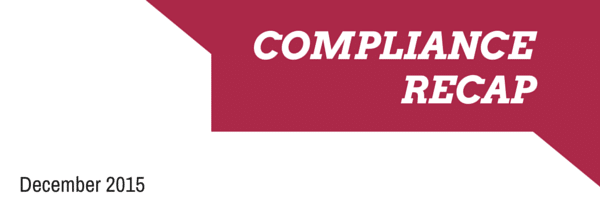2015 went out with a bang, as federal agencies and the White House issued a number of major delays relating to employee benefits. Most significantly, IRS reporting for the Patient Protection and Affordable Care Act’s play or pay requirement has been delayed, for both forms being sent to employees and forms being sent to the IRS. The Cadillac tax was also delayed two years, and commuter transit benefit parity was permanently achieved.
UBA Guides and Compliance Documents
UBA released a guide on the interplay of the Consolidated Omnibus Budget Reconciliation Act (COBRA) and the ACA.
UBA released a guide on HIPAA nondiscrimination rules that must be considered when making plan design decisions.
Omnibus Legislation
President Obama has signed the omnibus legislation that includes the Consolidated Appropriations Act for 2016 and a tax extenders package. The agreement will keep the federal government running through September 2016. Within the legislation is language that significantly impacts provisions of the Patient Protection and Affordable Care Act (ACA), largely through delays of upcoming taxes.
The most significant delay contained in the omnibus bill is a two-year delay on the “Cadillac tax” or the 40 percent excise tax on high-cost health insurance.
The omnibus bill also put a moratorium on the Health Insurance Provider (HIP) fee for 2017, which went into effect in 2013 and will return in 2018. The HIP fee imposes an aggregate annual tax apportioned among health insurers of “United States health risks” whose annual net premiums written exceed $25 million based on relative market share.
Read more about the omnibus legislation.
6055 and 6056 Reporting Delay
On December 28, 2015, the IRS issued Notice 2016-4, delaying the ACA’s employer shared responsibility reporting deadlines.
The reporting requirements are in Sections 6055 and 6056 of the ACA. Forms 1094-C, 1095-C, 1094-B, and 1095-B were originally due to the IRS by February 28 if filing on paper (by February 29 in 2016, because February 28 falls on the weekend), or March 31 if filing electronically. The 1095-C form was due to employees by January 31 of the year following the year to which the Form 1095-C relates (February 1 in 2016, because January 31 falls on a weekend). The 1095-B was due to the individual identified as the “responsible individual” on the form by January 31 (February 1 in 2016, because January 31 falls on a weekend).
The transition relief provided by Notice 2016-4 extended the due date for furnishing Form 1095-B and 1095-C to individuals to March 31, 2016. The due date for filing all forms (1094-C, 1095-C, 1094-B, and 1095-B) to the IRS is moved from February 29, 2016, to May 31, 2016, if filing by paper. If filing electronically, the date is moved to June 30, 2016.

IRS Notice 2015-87
On December 16, 2015, the Internal Revenue Service (IRS) and other federal agencies released IRS Notice 2015-87, which is a “potpourri” update that covers many different topics relating to the ACA, including some relating to market reforms.
The Notice generally covers health reimbursement arrangements (HRAs) and other employer payment plans, the impact of HRAs, flex credits, opt-out incentives or fringe benefit payments on affordability calculations relating to applicable large employers (ALEs), IRS reporting that is required for ALEs, rules for health savings accounts (HSAs) for individuals eligible for benefits administered from the Department of Veterans Affairs (VA), COBRA rules in relation to unused health flexible spending arrangement (HFSA) funds and a reiteration of safe harbors relating to good faith reporting for ALEs.
Read more about IRS Notice 2015-87.
Commuter Benefit Parity
The omnibus legislation that was signed into law also equalized commuter benefits between benefits for public transit passes and vanpools versus benefits for qualified parking. In 2015 the maximum tax-exclusion for public transit and vanpool went from $250 to $130 and remained at $250 for qualified parking. The omnibus legislation updates the 2016 maximum monthly tax exclusion for both public transit passes, vanpools, and qualified parking benefits to $255. It retroactively raises the 2015 maximum for public transit passes and vanpools from $130 to $250. Employers who provided taxable transit benefits above $130 and up to $250 in 2015 will need to make adjustments to quarterly tax returns and refund employees that had over withholdings.
IRS Final Rule on Minimum Value
In December 2015, the Internal Revenue Service (IRS) issued a final rule that clarifies various topics relating to the Patient Protection and Affordable Care Act (ACA) and premium tax credit eligibility provisions. The rule finalizes regulations that were proposed years earlier on topics such as inclusion of a child’s income in household income, factoring in wellness incentives for affordability, and mid-month enrollment of newborns and other dependents due to adoption, foster placement and similar situations.
Question of the Month
Q. What are the ACA’s affordability and penalty calculation percentages for 2015 and 2016?
A. The affordability of coverage was originally defined as costing no more that 9.5 percent of household income (or 9.5 percent of wages or of the federal poverty level) and it is adjusted annually. The IRS will be amending regulations to reflect these adjustment amounts and will update the percentage via IRS notice in future years. For 2015 this is set at 9.56 percent and for 2016 it is set at 9.66 percent.
Under the ACA, an ALE must offer minimum essential coverage to most of its full-time employees (and dependents) or pay a $2,000 per year ($166.67 per month), indexed, penalty on all of its full-time employees, if even one employee receives a premium tax credit. An ALE must also offer minimum value, affordable coverage to its full-time employees or pay a penalty of $3,000 a year ($250 per month), indexed.
The indexed amounts for the $2,000 penalty, based on calendar years, are:
2015: $2,080
2016: $2,160
The indexed amounts for the $3,000 penalty, based on calendar years, are:
2015: $3,120
2016: $3,240












